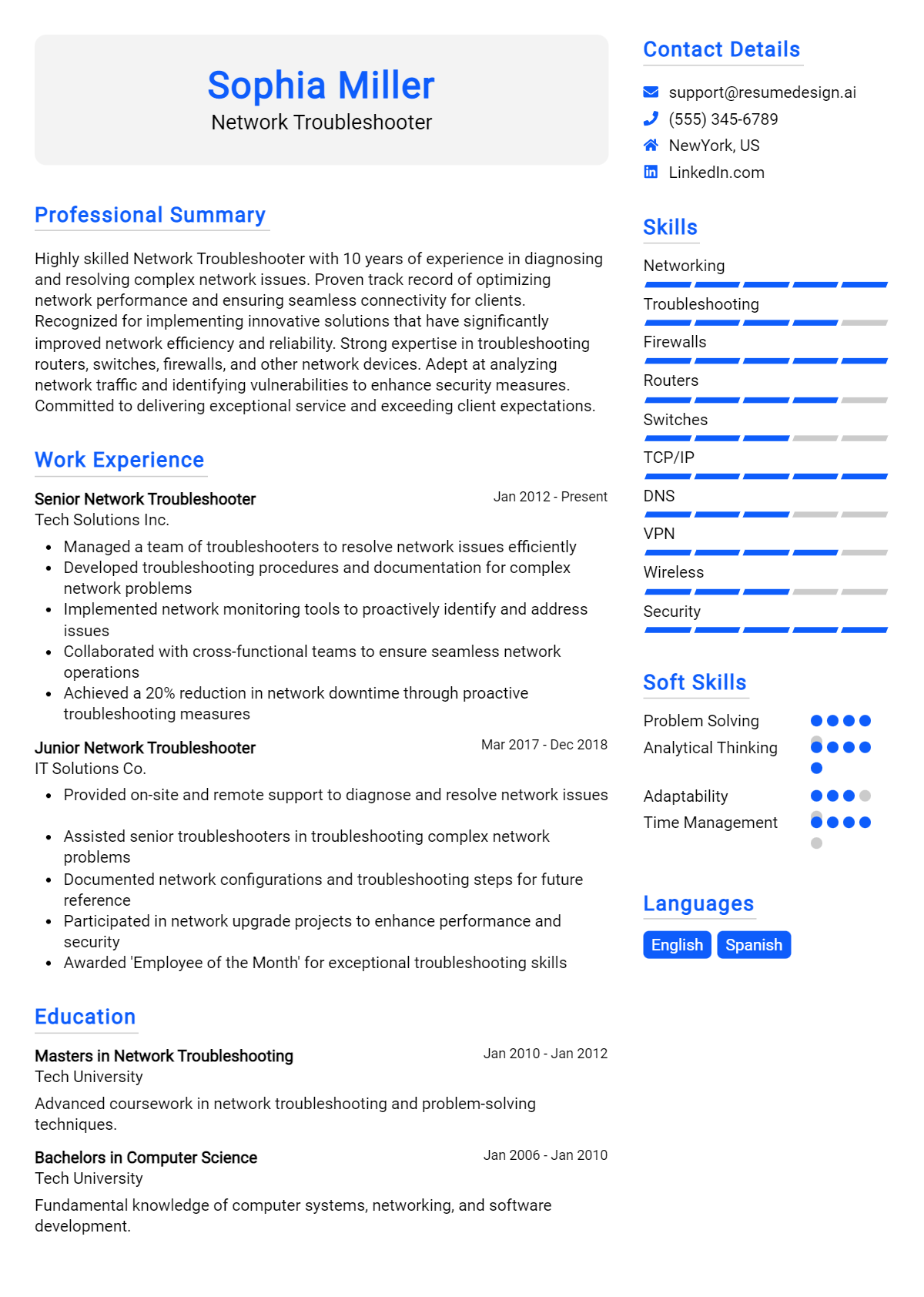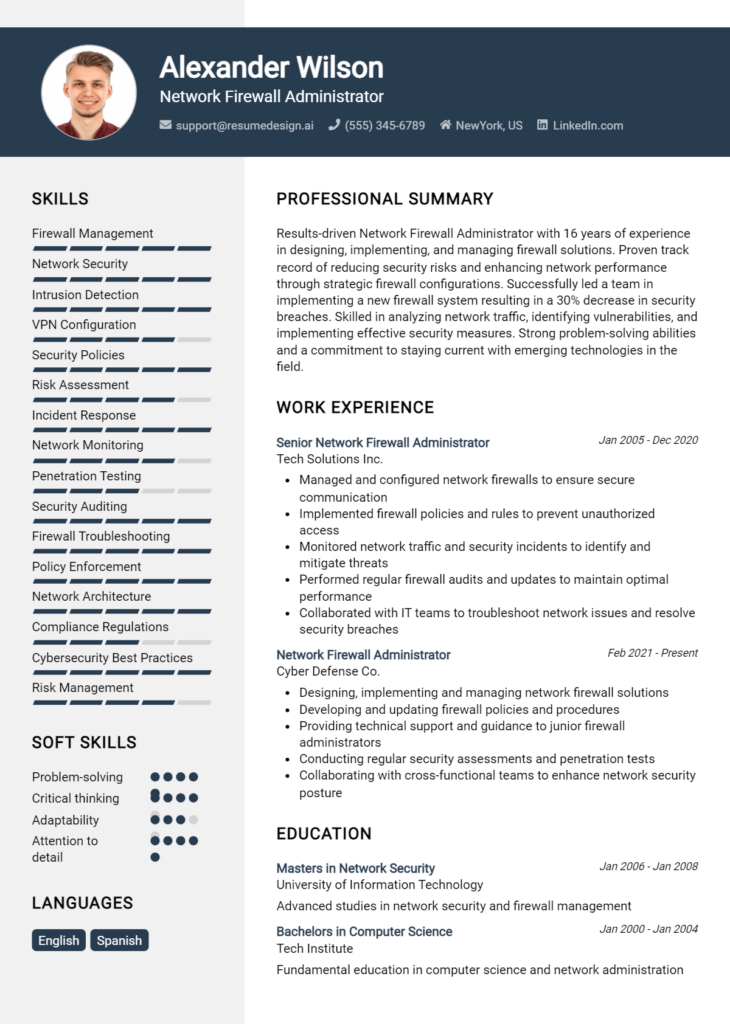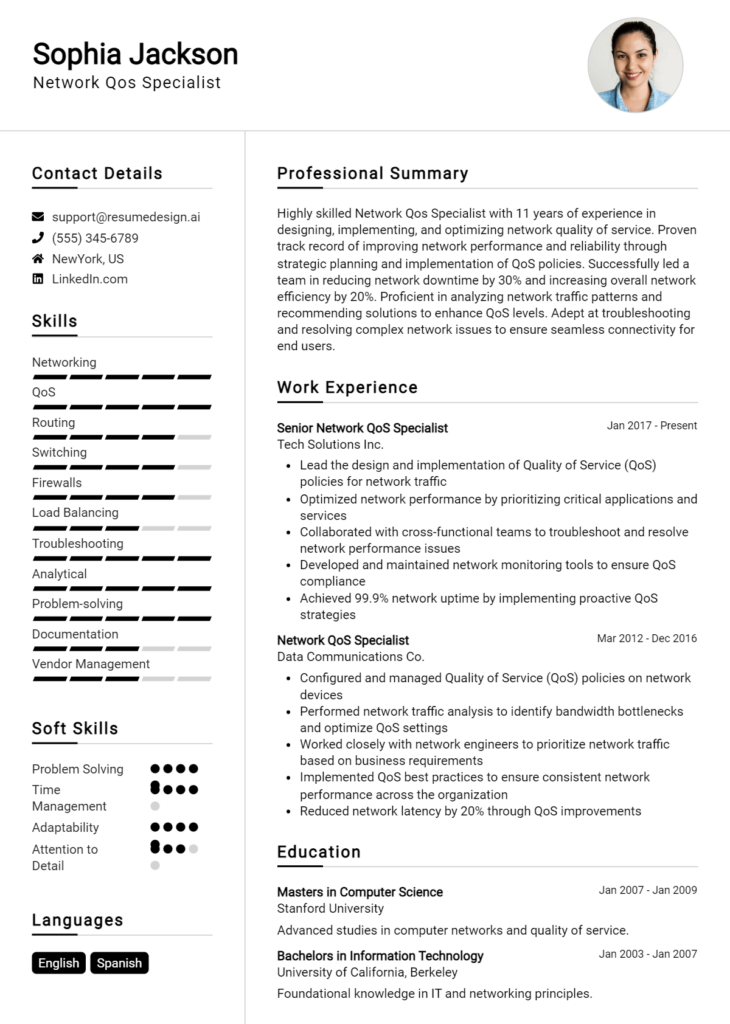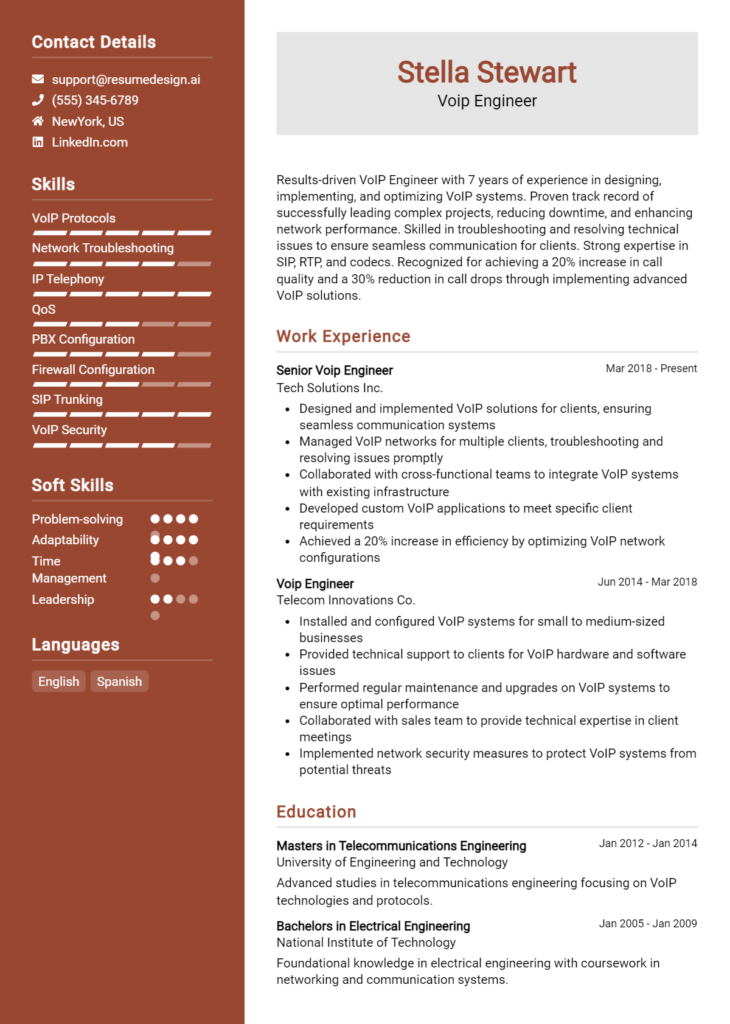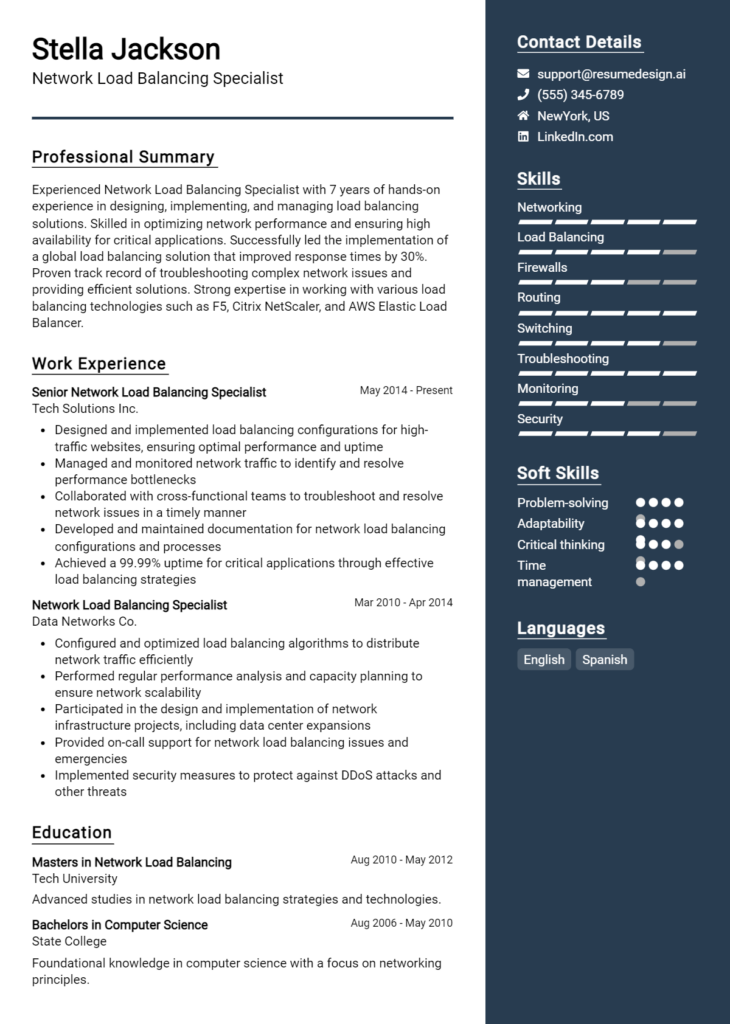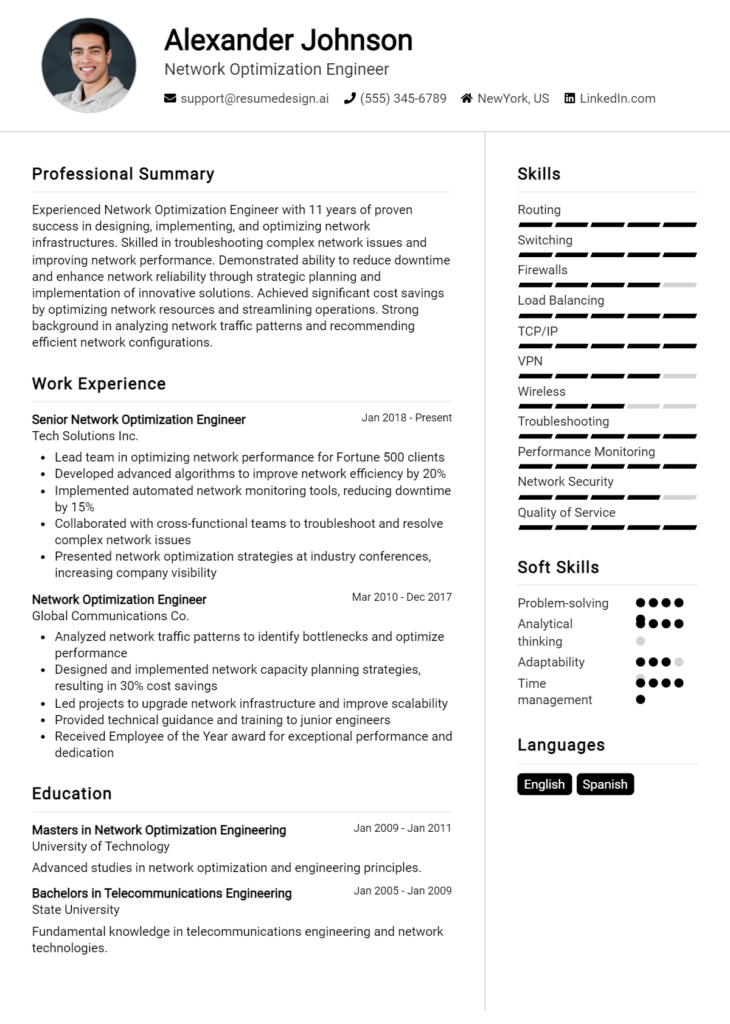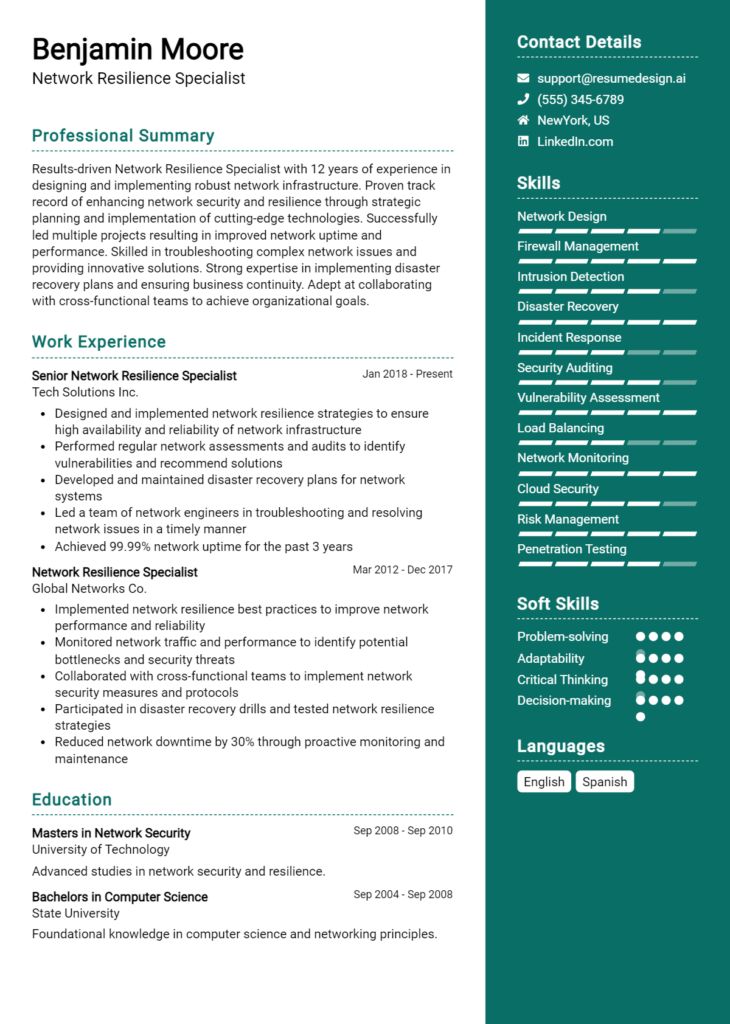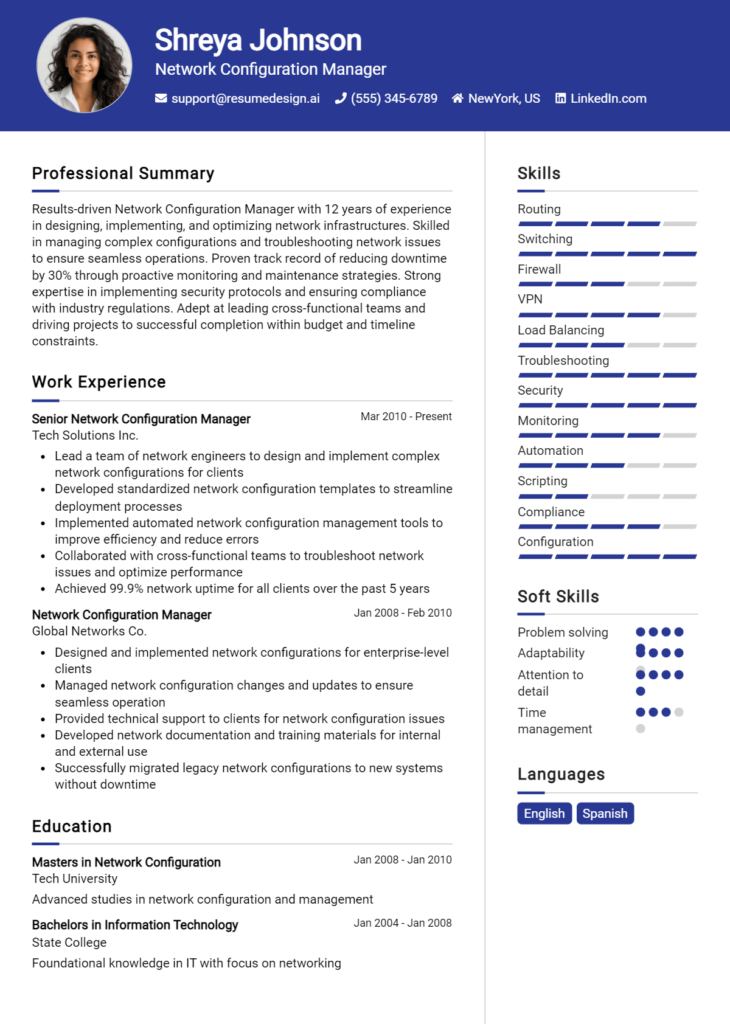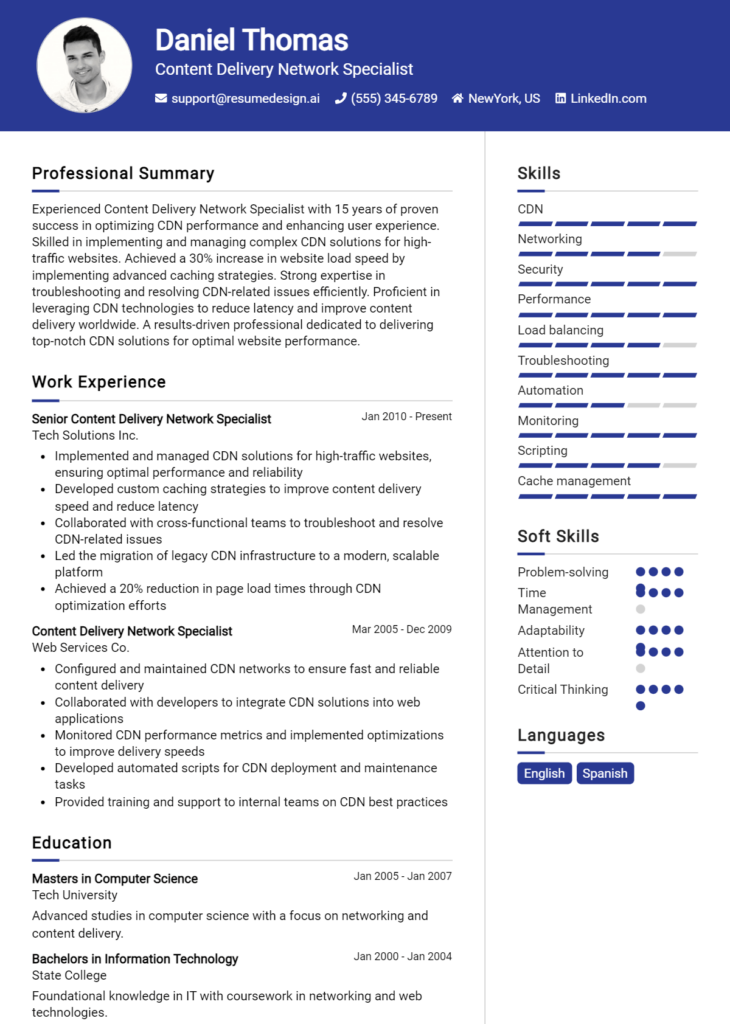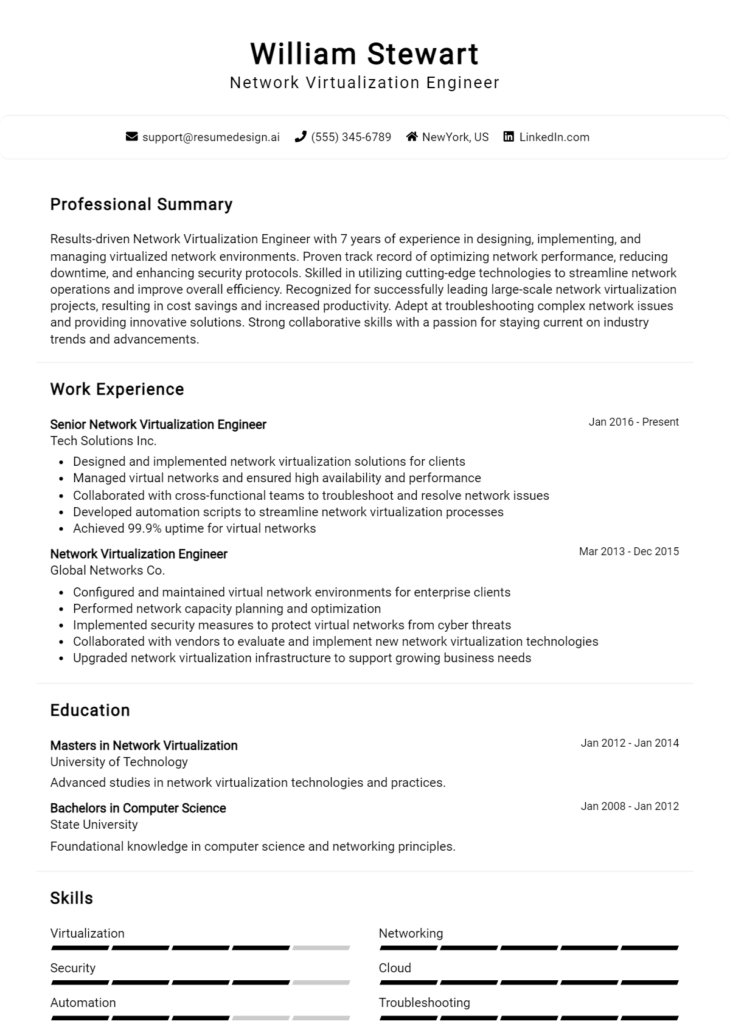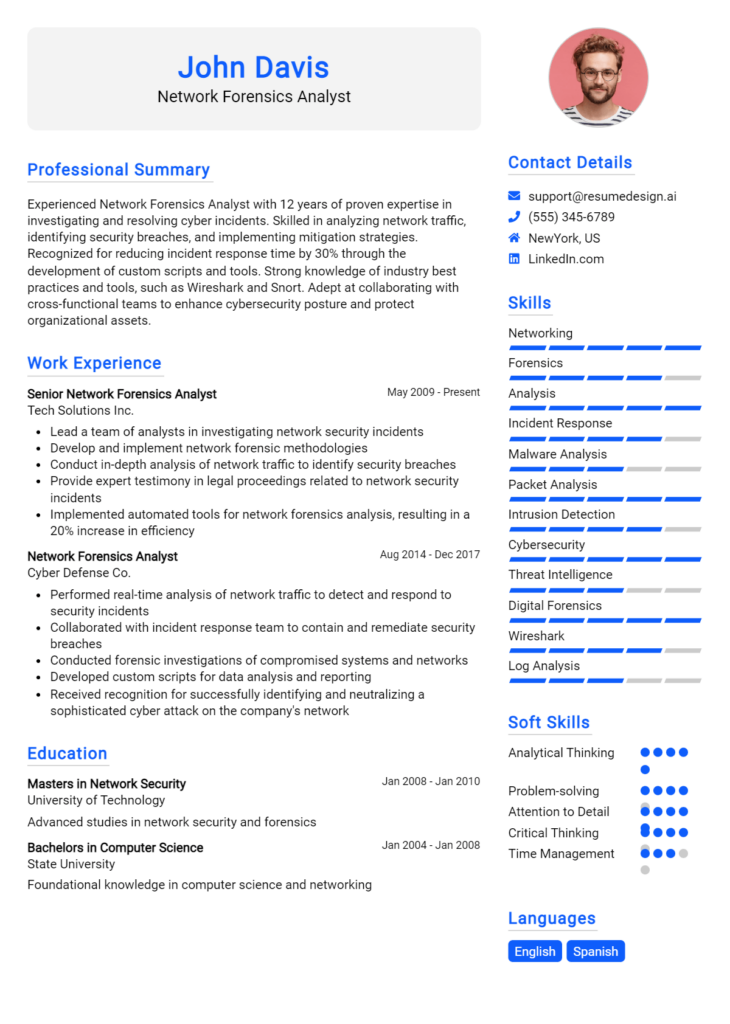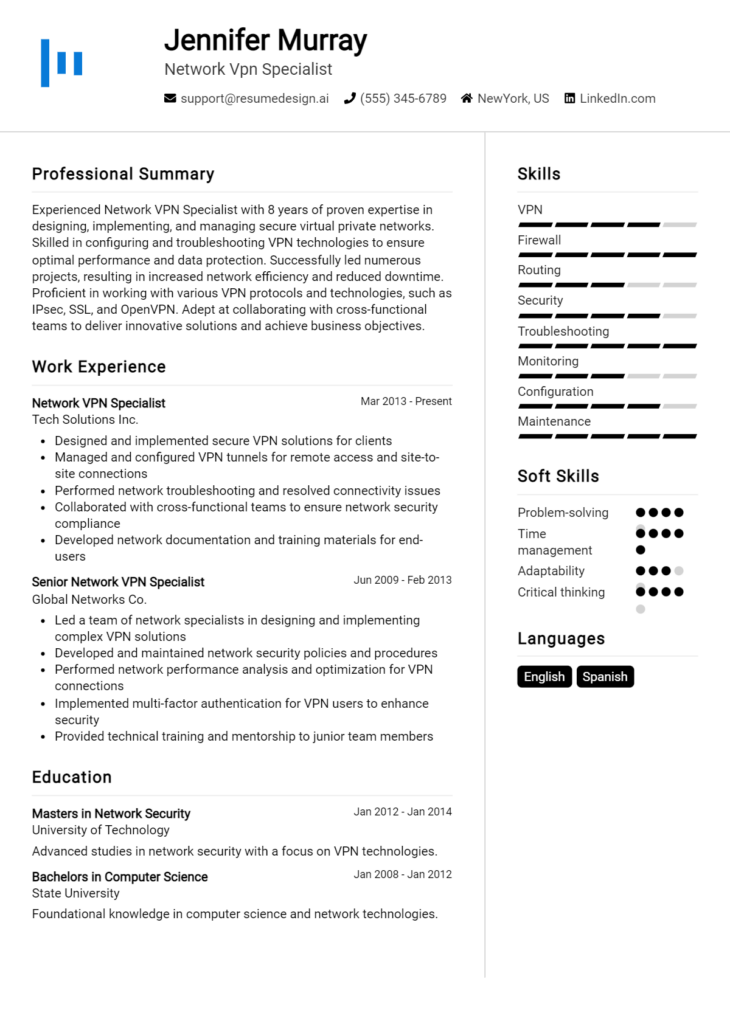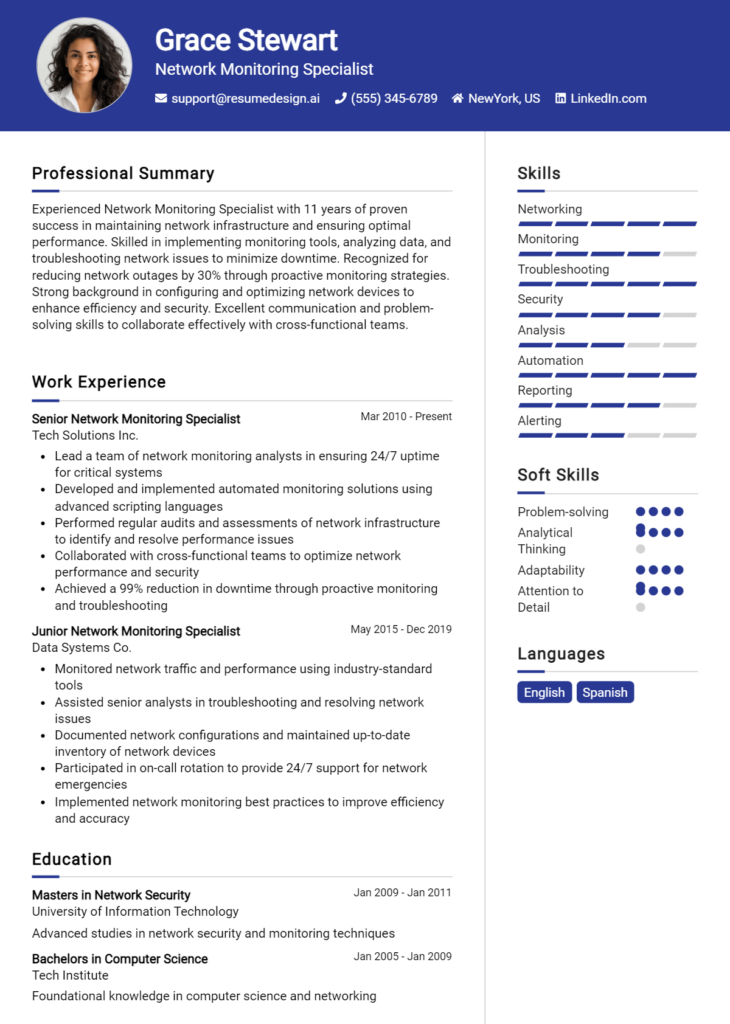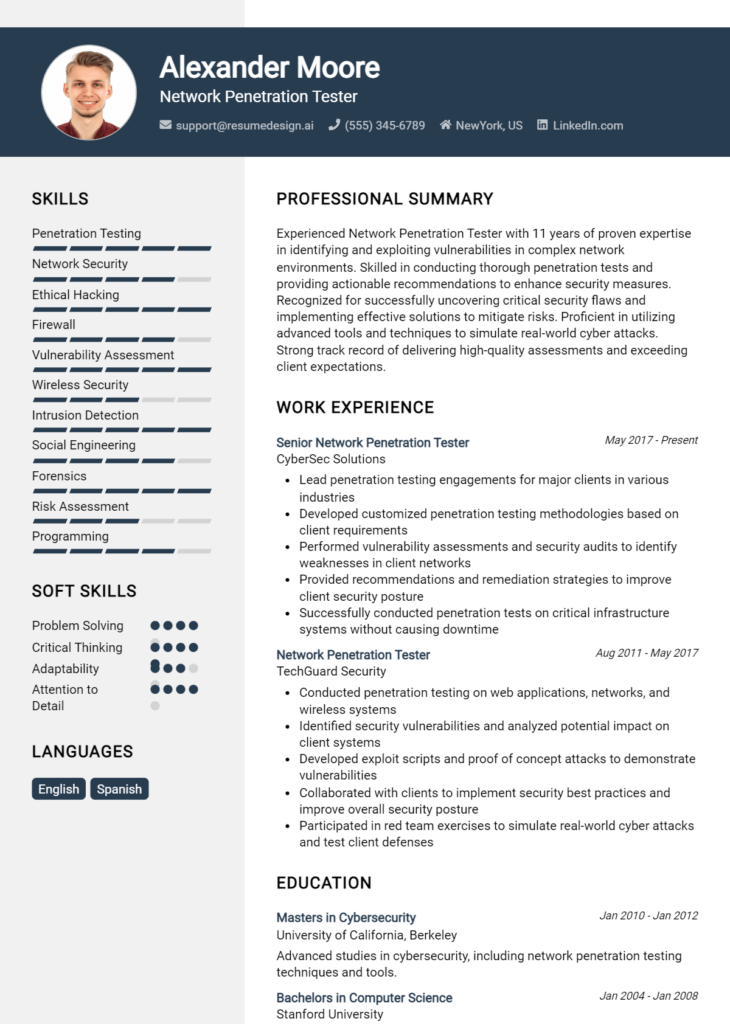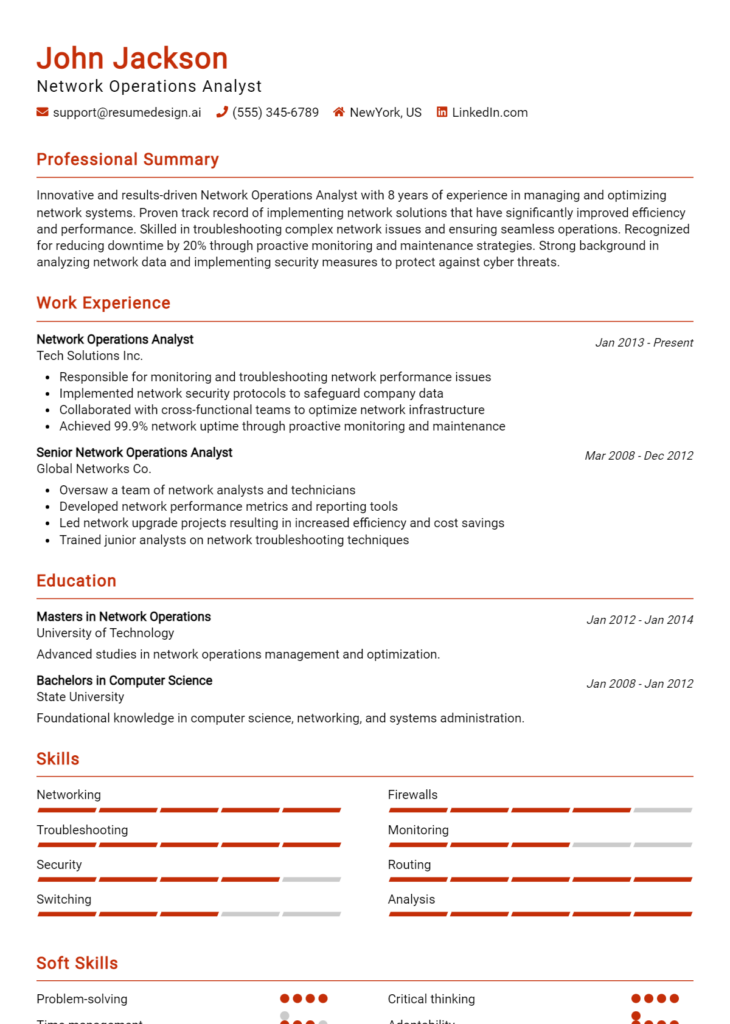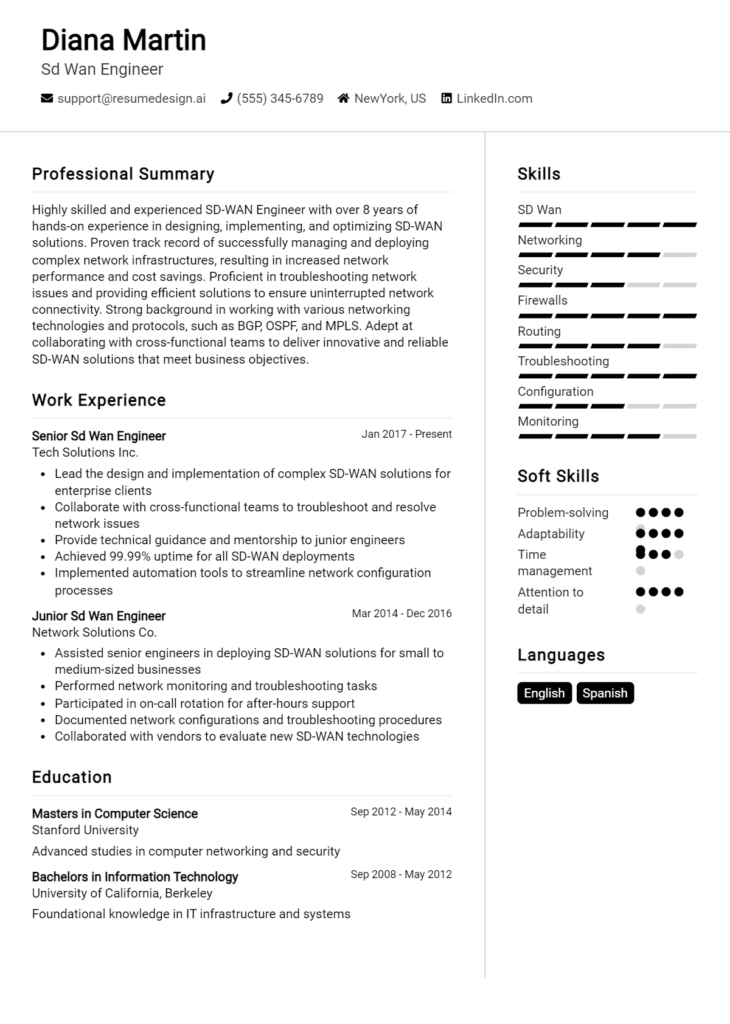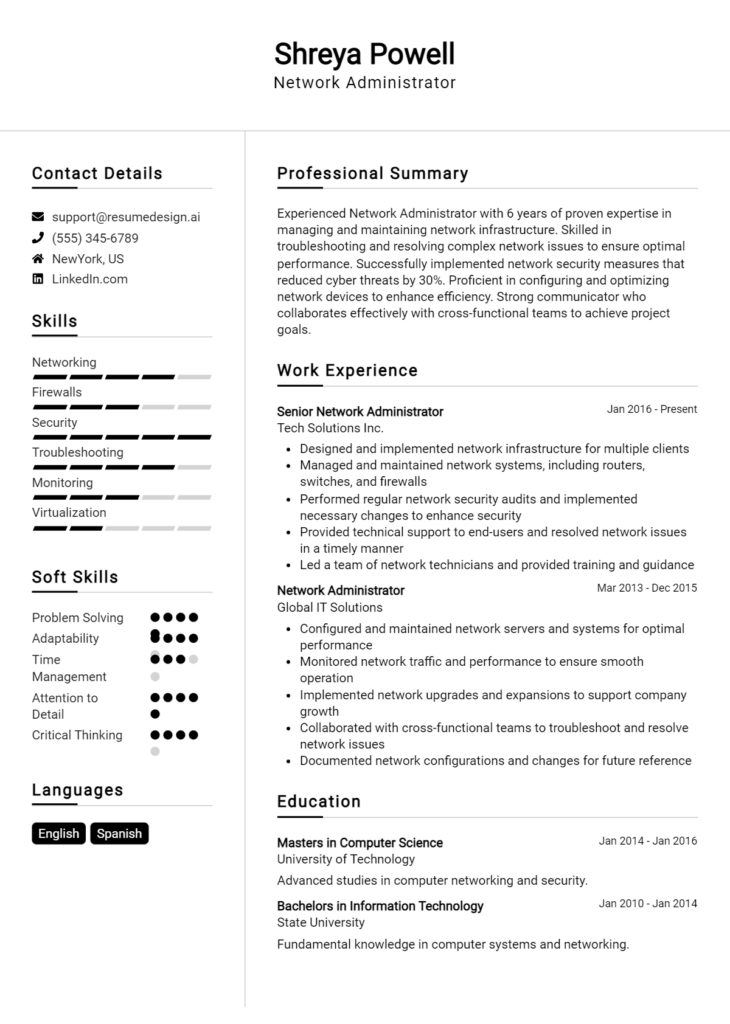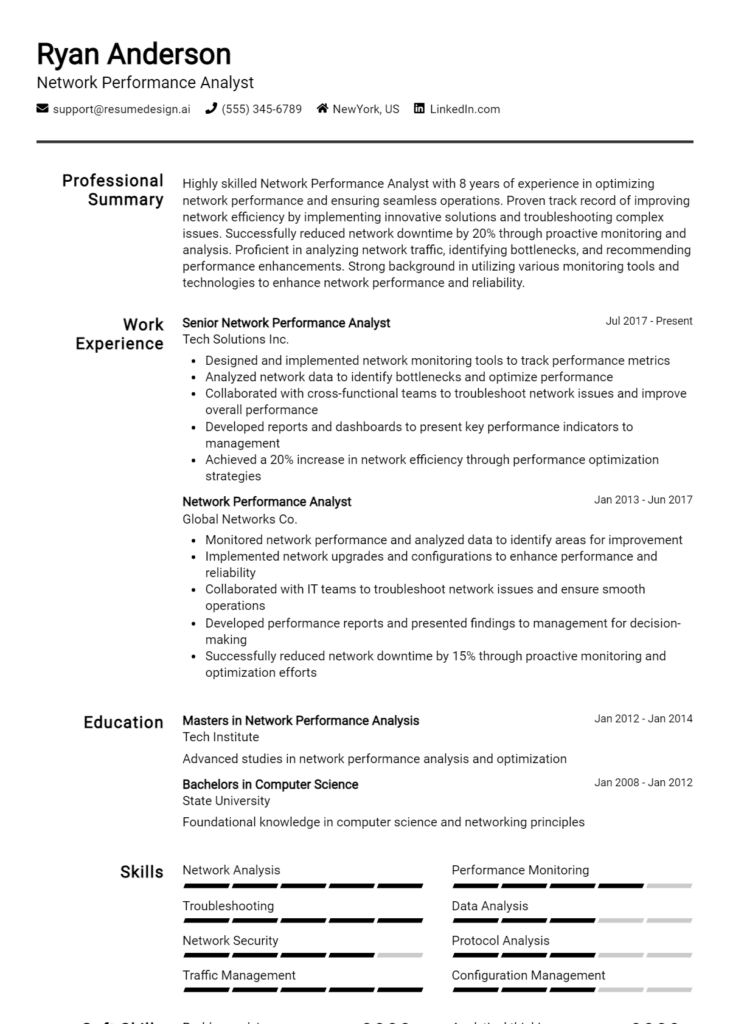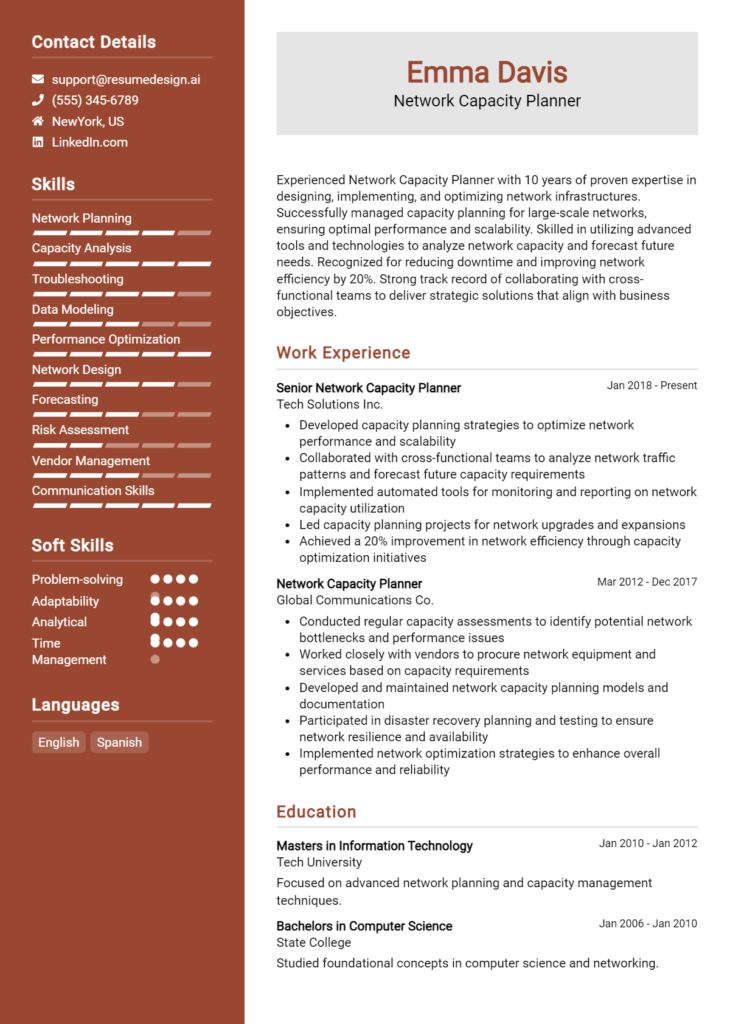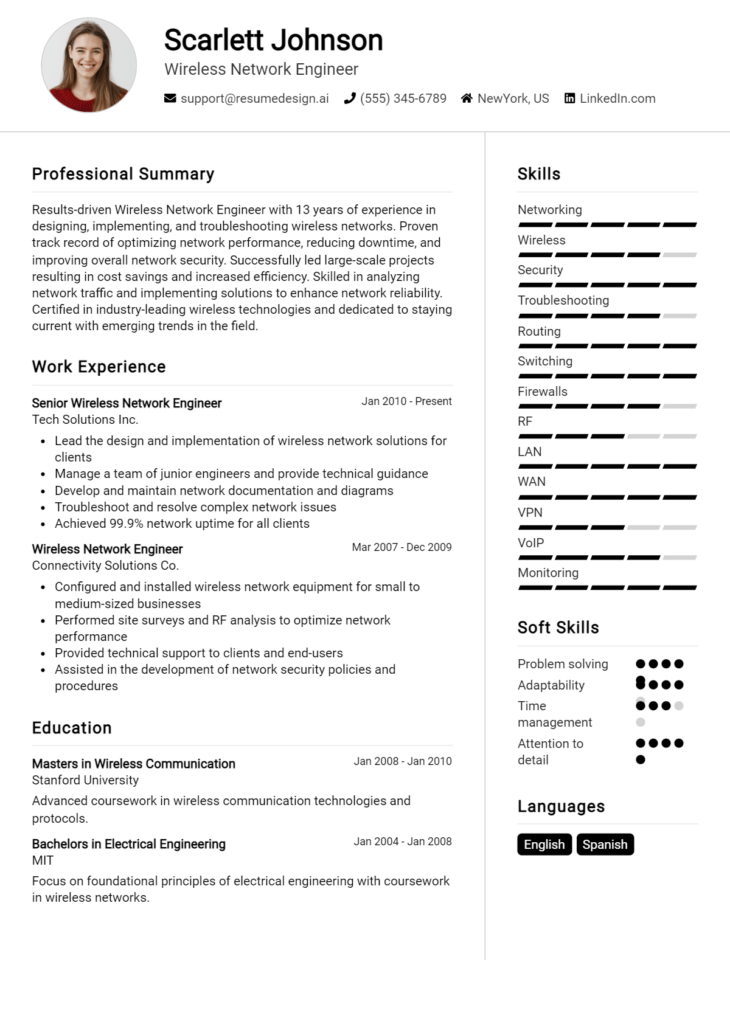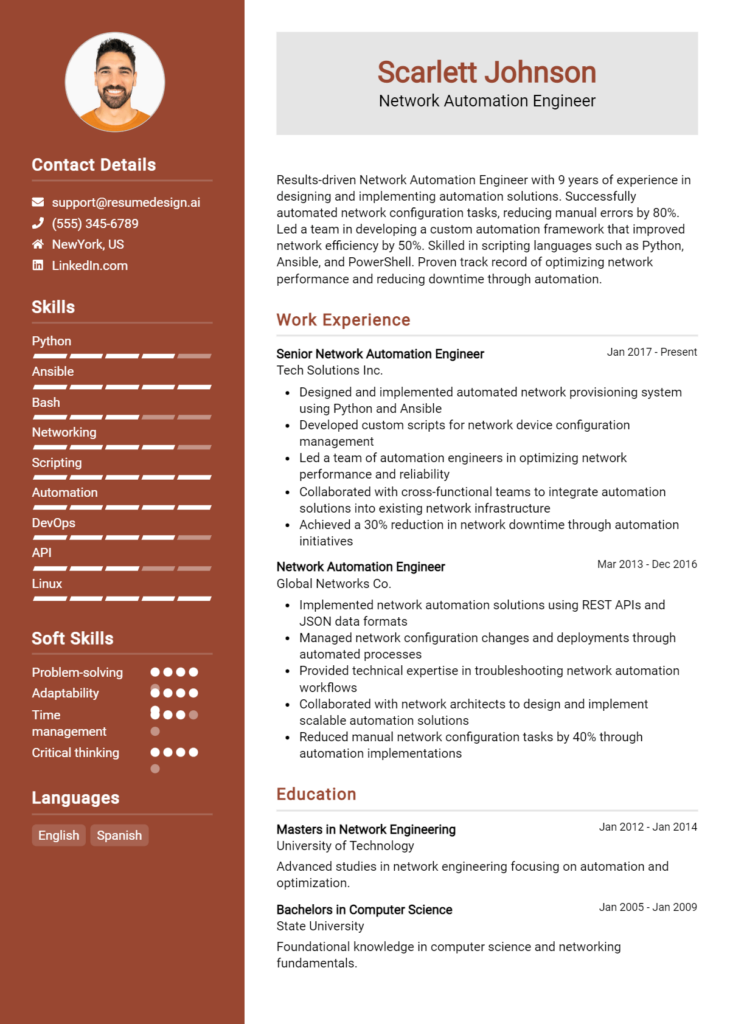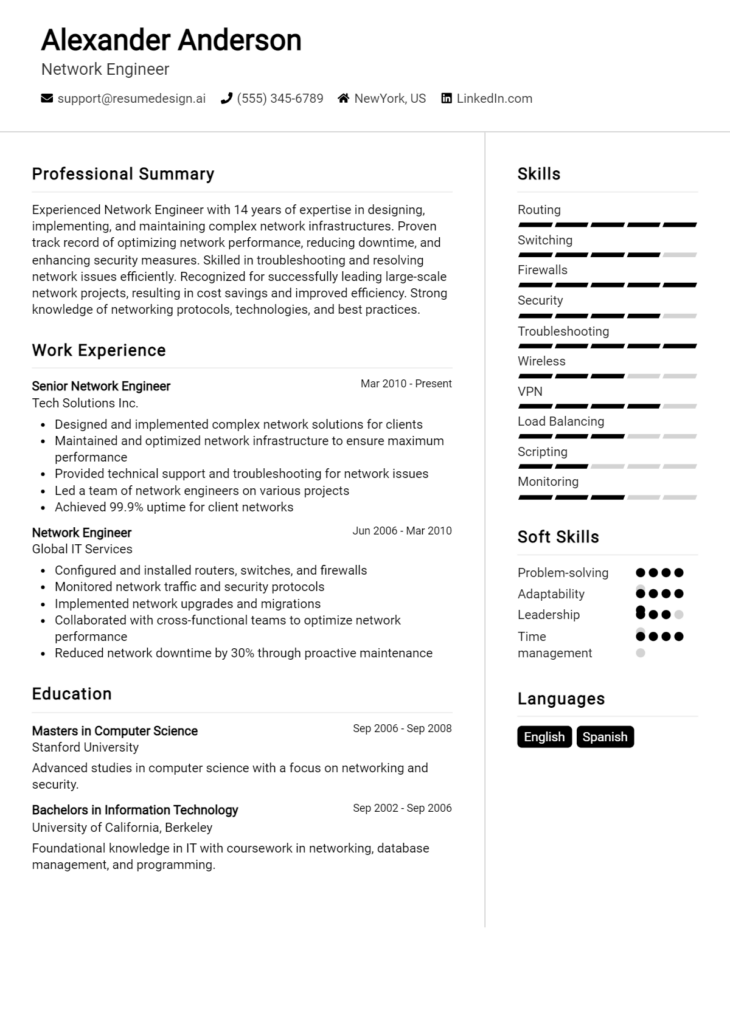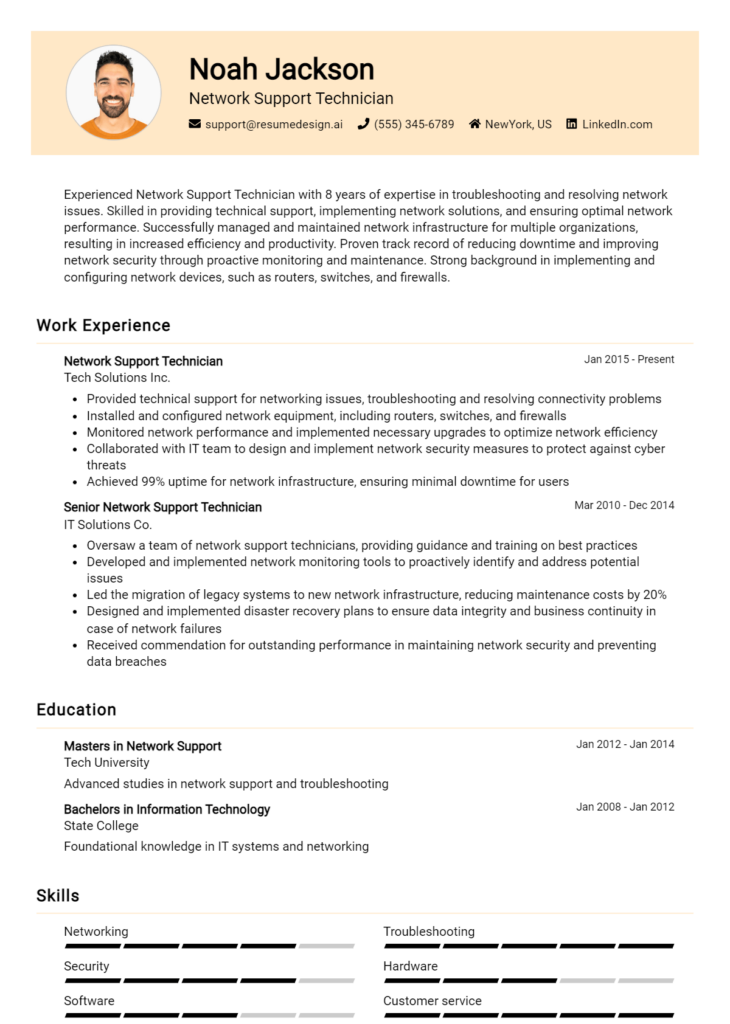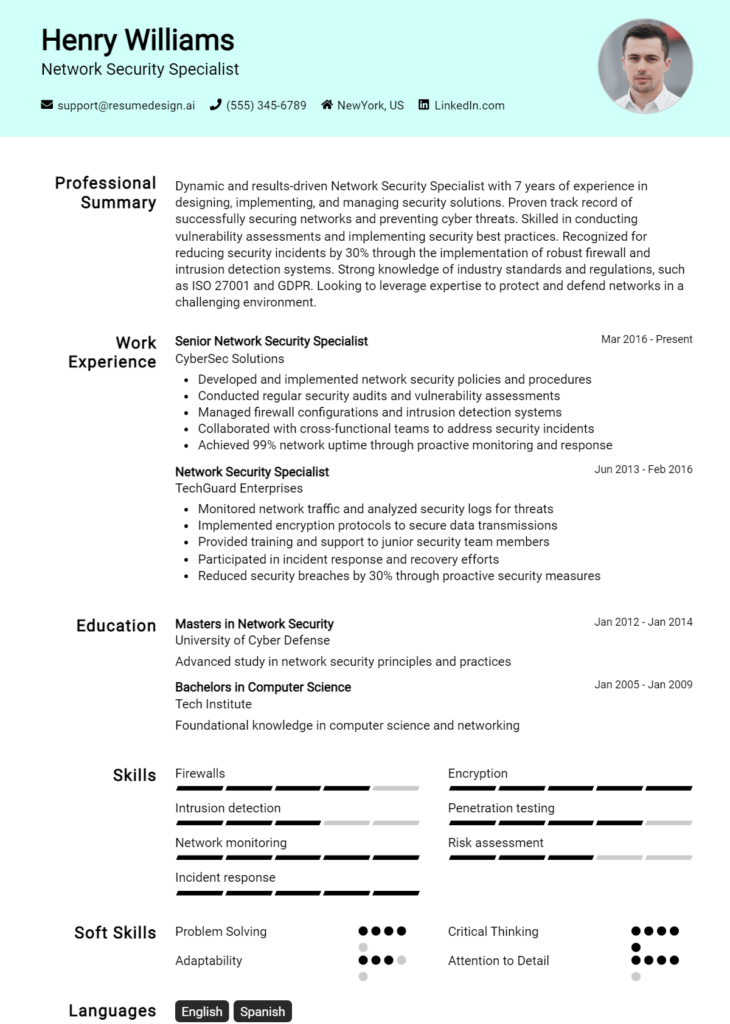Network Troubleshooter Core Responsibilities
A Network Troubleshooter plays a vital role in ensuring seamless connectivity across various departments by diagnosing and resolving network issues. Key responsibilities include monitoring network performance, conducting preventive maintenance, and collaborating with IT teams to implement solutions. Strong technical skills in networking protocols, operational acumen, and advanced problem-solving abilities are essential to excel in this role. These skills not only support daily operations but also align with the organization’s broader goals, making a well-structured resume crucial for showcasing these qualifications effectively.
Common Responsibilities Listed on Network Troubleshooter Resume
- Diagnose and resolve network connectivity issues.
- Monitor network performance and conduct regular assessments.
- Collaborate with IT staff to enhance network infrastructure.
- Implement network security protocols and policies.
- Provide technical support to end-users and departments.
- Document network configurations and changes accurately.
- Perform preventive maintenance and upgrades on network equipment.
- Analyze network traffic and optimize bandwidth usage.
- Train staff on network-related issues and best practices.
- Maintain inventory of network devices and software.
- Assist in planning and executing network projects.
- Stay updated with emerging networking technologies and trends.
High-Level Resume Tips for Network Troubleshooter Professionals
In today's competitive job market, a well-crafted resume is crucial for Network Troubleshooters who want to stand out from the crowd. As the first impression a candidate makes on potential employers, a resume must effectively showcase both technical skills and professional achievements. For Network Troubleshooters, this means highlighting experiences that demonstrate problem-solving abilities, technical proficiency, and a keen understanding of networking systems. This guide will provide practical and actionable resume tips specifically tailored for Network Troubleshooter professionals, ensuring that your resume reflects your qualifications and sets you apart in the hiring process.
Top Resume Tips for Network Troubleshooter Professionals
- Tailor your resume to each job description, emphasizing relevant skills and experiences that match the requirements.
- Include a strong summary statement at the top, summarizing your expertise in network troubleshooting and your career goals.
- List your technical skills prominently, including specific software, hardware, and networking protocols you are proficient in.
- Quantify your achievements with metrics, such as the number of networks optimized or downtime reduced through your troubleshooting efforts.
- Highlight certifications relevant to network troubleshooting, such as CompTIA Network+, Cisco Certified Network Associate (CCNA), or Certified Information Systems Security Professional (CISSP).
- Use action verbs to describe your experience, such as "diagnosed," "executed," "resolved," and "implemented" to convey a sense of proactivity.
- Showcase projects or specific cases where you successfully troubleshot complex network issues, detailing the steps taken and outcomes achieved.
- Incorporate keywords from the job posting to improve your resume's chances of passing through applicant tracking systems.
- Keep the formatting clean and professional, using bullet points for easy readability and ensuring consistent font and style choices.
By implementing these tips, Network Troubleshooter professionals can significantly increase their chances of landing a job in this dynamic field. A well-structured and tailored resume not only highlights your skills and accomplishments but also demonstrates your commitment to the profession, making you a more attractive candidate to potential employers.
Why Resume Headlines & Titles are Important for Network Troubleshooter
In the competitive landscape of job applications, a well-crafted resume headline or title is essential for a Network Troubleshooter. This brief but impactful phrase serves as the first impression for hiring managers, summarizing a candidate's key qualifications and strengths in a concise manner. A strong headline not only captures attention but also sets the tone for the rest of the resume, making it clear how the candidate's skills align with the demands of the role. Therefore, it is crucial for applicants to create headlines that are relevant, direct, and reflective of their expertise in network troubleshooting.
Best Practices for Crafting Resume Headlines for Network Troubleshooter
- Keep it concise: Aim for a headline that is no longer than 10-12 words.
- Be specific: Clearly mention your area of expertise, such as “Network Troubleshooter” or “Network Support Specialist.”
- Highlight key skills: Incorporate relevant skills, such as “Expert in Troubleshooting Network Connectivity Issues.”
- Use action verbs: Start with strong verbs to convey your proactivity, like “Driven Network Troubleshooter.”
- Tailor to the job: Customize your headline for each application based on the job description.
- Include measurable achievements: If possible, reference achievements, like “Network Troubleshooter with 95% Issue Resolution Rate.”
- Avoid jargon: Use clear language that anyone in HR can understand.
- Make it compelling: Aim to create intrigue that encourages the hiring manager to read more.
Example Resume Headlines for Network Troubleshooter
Strong Resume Headlines
Dynamic Network Troubleshooter with 7+ Years of Experience in Enterprise Environments
Certified Network Specialist Skilled in Rapid Issue Resolution and System Optimization
Proven Network Troubleshooter with Track Record of Enhancing System Uptime by 30%
Versatile Network Support Expert Committed to Delivering 24/7 Solutions
Weak Resume Headlines
Job Seeker Looking for Opportunities in IT
Network Troubleshooting Professional
Experienced IT Specialist
The strong headlines are effective because they succinctly encapsulate the candidate's unique strengths, experience, and accomplishments while directly relating to the role of a Network Troubleshooter. They are specific and action-oriented, making them memorable. In contrast, the weak headlines lack detail and specificity, failing to differentiate the candidate from others. They do not convey a clear understanding of the candidate’s qualifications or how they align with the job requirements, ultimately leading to missed opportunities for engagement with hiring managers.
Writing an Exceptional Network Troubleshooter Resume Summary
A well-crafted resume summary is crucial for a Network Troubleshooter, serving as the first impression to hiring managers. This brief section provides a snapshot of the candidate's key skills, relevant experience, and notable accomplishments, enabling them to quickly gauge the applicant's qualifications. A strong summary should be concise and impactful, tailored specifically to the job being applied for, highlighting the candidate's ability to diagnose and resolve networking issues efficiently. By capturing the essence of a candidate's expertise in a few sentences, a compelling resume summary sets the tone for the rest of the application and can significantly increase the chances of landing an interview.
Best Practices for Writing a Network Troubleshooter Resume Summary
- Quantify achievements to showcase the impact of your work, such as reduced downtime or improved network efficiency.
- Focus on key skills relevant to network troubleshooting, including specific technologies, tools, and methodologies.
- Tailor the summary to match the job description, using keywords that align with the employer's needs.
- Highlight certifications or specialized training that enhance your qualifications for the role.
- Emphasize problem-solving abilities and successful troubleshooting experiences.
- Keep it concise, ideally between two to four sentences, to maintain the reader's attention.
- Use action verbs to convey a sense of proactivity and achievement.
- Showcase your passion for technology and continuous learning in the field of networking.
Example Network Troubleshooter Resume Summaries
Strong Resume Summaries
Dedicated Network Troubleshooter with over 5 years of experience resolving complex networking issues, achieving a 30% reduction in downtime through proactive monitoring and swift incident response. Proficient in Cisco, Juniper, and various network diagnostic tools.
Results-driven IT professional with a proven track record of enhancing network performance and reliability, having successfully reduced latency by 25% for a mid-sized firm. Skilled in both wired and wireless technologies, with expertise in troubleshooting TCP/IP and VLAN configurations.
Certified Network Engineer with extensive experience in diagnosing and fixing network problems. Increased overall client satisfaction ratings by 40% through effective communication and timely resolution of technical issues.
Weak Resume Summaries
Experienced in network troubleshooting and general IT tasks. I have worked in various environments and am familiar with many tools.
I am a network troubleshooter looking for a job. I have skills that could be useful and am willing to learn more.
The strong resume summaries are effective because they provide specific accomplishments, quantify results, and directly align with the responsibilities of a Network Troubleshooter. They demonstrate the candidate's ability to make a positive impact on network performance and reliability. In contrast, the weak summaries lack detail and specificity, failing to convey any measurable outcomes or relevant skills, which may leave hiring managers unimpressed and uncertain about the candidate's actual capabilities.
Work Experience Section for Network Troubleshooter Resume
The work experience section of a Network Troubleshooter resume is vital as it serves as a comprehensive showcase of the candidate's technical skills and problem-solving capabilities. This section not only highlights the candidate's hands-on experience with various networking technologies but also emphasizes their ability to manage teams and deliver high-quality network solutions. By quantifying achievements and aligning experiences with industry standards, candidates can effectively demonstrate their value to potential employers, making this section a crucial element of the resume.
Best Practices for Network Troubleshooter Work Experience
- Focus on quantifiable results by including metrics such as uptime percentages, problem resolution times, and cost savings.
- Highlight specific technical skills relevant to the job role, including certifications, tools, and methodologies used.
- Demonstrate leadership abilities by detailing experiences in managing projects or teams effectively.
- Showcase collaboration with cross-functional teams to solve complex network issues.
- Utilize action verbs to convey a proactive and results-driven approach.
- Tailor the work experience section to align with the specific requirements of the job description.
- Include relevant industry standards and best practices to showcase knowledge and adherence to protocols.
- Provide context for each position, explaining the environment and scope of responsibilities to add depth to your experience.
Example Work Experiences for Network Troubleshooter
Strong Experiences
- Led a team of 5 network technicians to reduce system downtime by 25% over 12 months through proactive monitoring and troubleshooting.
- Implemented a new network security protocol that resulted in a 40% decrease in security breaches within the first year.
- Coordinated the successful migration of a legacy network system to a cloud-based solution, improving speed by 30% and reducing operational costs by 20%.
- Developed and executed training programs for team members on advanced troubleshooting techniques, increasing departmental efficiency by 15%.
Weak Experiences
- Responsible for network issues and troubleshooting.
- Worked with team members to resolve problems as they arose.
- Involved in network maintenance activities.
- Helped with various technical tasks as needed.
The examples provided showcase a clear distinction between strong and weak experiences. Strong experiences are characterized by specific, quantifiable outcomes and demonstrate leadership, technical expertise, and successful collaboration within teams. In contrast, weak experiences lack detail and specificity, making it difficult for potential employers to gauge the candidate's actual contributions and skills. By focusing on measurable achievements and impactful roles, candidates can effectively position themselves as top contenders in the competitive job market for network troubleshooting roles.
Education and Certifications Section for Network Troubleshooter Resume
The education and certifications section of a Network Troubleshooter resume is crucial as it showcases the candidate's academic background and industry-relevant qualifications. This section not only highlights the formal education the candidate has received but also emphasizes ongoing professional development through certifications and specialized training. By providing a detailed overview of relevant coursework, recognized credentials, and continuous learning efforts, candidates can significantly enhance their credibility and demonstrate their alignment with the demands of the job role. This is essential in a competitive field where technical expertise and up-to-date knowledge are critical for success.
Best Practices for Network Troubleshooter Education and Certifications
- Focus on relevant degrees such as Computer Science, Information Technology, or Network Engineering.
- Include industry-recognized certifications like CompTIA Network+, Cisco CCNA, or Juniper JNCIA.
- Detail any specialized training programs that pertain to network troubleshooting and management.
- Provide information on relevant coursework that directly relates to networking principles and troubleshooting.
- List certifications in chronological order to highlight continuous learning and recent accomplishments.
- Highlight any advanced degrees or specialized certifications that demonstrate a higher level of expertise.
- Ensure all entries are up-to-date and reflect the candidate's current skill set.
- Consider including online courses or workshops that showcase a commitment to staying current in the field.
Example Education and Certifications for Network Troubleshooter
Strong Examples
- Bachelor of Science in Network Engineering, ABC University, 2020
- CompTIA Network+ Certification, Issued June 2021
- Cisco Certified Network Associate (CCNA), Issued January 2022
- Coursework in Advanced Network Troubleshooting Techniques, XYZ Training Institute, 2023
Weak Examples
- Associate of Arts in General Studies, DEF College, 2018
- Microsoft Certified Professional (MCP), Issued 2015
- Certification in Basic Computer Skills, GHI Training Center, 2016
- Coursework in English Literature, QRS University, 2019
The strong examples are considered relevant because they directly align with the skills and knowledge required for a Network Troubleshooter, showcasing targeted education and certifications that enhance the candidate's qualifications. Conversely, the weak examples demonstrate a lack of relevance to the field, with outdated or unrelated credentials that do not contribute to the candidate’s expertise in network troubleshooting, thereby diminishing their appeal to potential employers.
Top Skills & Keywords for Network Troubleshooter Resume
In the ever-evolving field of Information Technology, a Network Troubleshooter plays a critical role in maintaining the integrity and efficiency of network systems. A well-crafted resume for this position not only highlights relevant experience but also emphasizes key skills that are essential for success in the role. Employers seek candidates who possess a balanced mix of hard and soft skills, enabling them to diagnose issues effectively and communicate solutions clearly. Demonstrating proficiency in these skills can significantly enhance a candidate’s appeal, showcasing their ability to navigate complex network environments and contribute to the overall productivity of an organization.
Top Hard & Soft Skills for Network Troubleshooter
Soft Skills
- Problem-solving
- Communication
- Attention to detail
- Analytical thinking
- Team collaboration
- Time management
- Adaptability
- Customer service orientation
- Conflict resolution
- Critical thinking
Hard Skills
- Network configuration and management
- Troubleshooting methodologies
- Familiarity with network protocols (TCP/IP, DNS, DHCP)
- Experience with network monitoring tools (Wireshark, Nagios)
- Firewall and security configuration
- Knowledge of hardware (routers, switches, modems)
- VPN setup and management
- Wireless networking technologies
- Scripting and automation (Python, Bash)
- Understanding of cloud networking concepts
To further develop your resume, consider exploring additional skills and how to showcase your relevant work experience effectively.
Stand Out with a Winning Network Troubleshooter Cover Letter
Dear [Hiring Manager's Name],
I am excited to apply for the Network Troubleshooter position at [Company Name], as advertised on [Job Board/Company Website]. With a robust background in network diagnostics and a passion for resolving complex connectivity issues, I am confident in my ability to contribute effectively to your team. My hands-on experience with a variety of networking protocols and technologies, combined with my analytical problem-solving skills, uniquely positions me to excel in this role.
In my previous role at [Previous Company Name], I successfully managed a range of network troubleshooting tasks, from diagnosing hardware failures to optimizing network performance. I employed various diagnostic tools and methodologies, ensuring minimal downtime and maintaining a seamless user experience. My proactive approach allowed me to identify potential network vulnerabilities and implement strategic solutions, reducing incident response time by over 30%. I thrive in fast-paced environments where quick thinking and effective communication are essential, and I am eager to bring this dedication to [Company Name].
Furthermore, I pride myself on my ability to collaborate with cross-functional teams, translating technical jargon into comprehensible terms for non-technical stakeholders. My commitment to continuous learning has led me to stay updated on the latest networking technologies, allowing me to implement best practices and enhance overall network efficiency. I am particularly impressed with [Company Name]'s commitment to innovative networking solutions and would be honored to contribute my skills to such a forward-thinking organization.
Thank you for considering my application. I look forward to the opportunity to discuss how my background and skills align with the needs of your team. I am excited about the potential to contribute to [Company Name] and help maintain the high standards of network functionality and reliability that your clients have come to expect.
Sincerely,
[Your Name]
[Your Phone Number]
[Your Email Address]
Common Mistakes to Avoid in a Network Troubleshooter Resume
When crafting a resume for a Network Troubleshooter position, it’s essential to highlight your technical skills and problem-solving abilities effectively. However, many applicants make common mistakes that can hinder their chances of landing an interview. Avoiding these pitfalls can differentiate your resume from the competition and showcase your qualifications in the best light. Here are some common mistakes to steer clear of:
Generic Objective Statement: Using a vague or generic objective statement fails to convey your specific goals and how they align with the company's needs. Tailor your objective to reflect your interest in the specific role.
Overloading Technical Jargon: While technical knowledge is crucial, overloading your resume with jargon can alienate non-technical hiring managers. Aim for clarity and balance between technical terms and understandable language.
Neglecting Soft Skills: Focusing solely on technical skills can give a one-dimensional view of your capabilities. Include soft skills like communication, teamwork, and adaptability, as they are vital for troubleshooting roles.
Lack of Quantifiable Achievements: Simply listing responsibilities without quantifying your achievements can make your experience seem less impactful. Use metrics to demonstrate how you improved network performance or resolved issues.
Ignoring Keywords from Job Descriptions: Failing to incorporate relevant keywords from the job description can result in your resume being overlooked by Applicant Tracking Systems (ATS). Tailor your resume to include these keywords.
Formatting Issues: A cluttered or overly complicated format can hinder readability. Use a clean, professional layout with clear headings and bullet points to make your resume easy to skim.
Omitting Relevant Certifications: Failing to mention relevant certifications, such as CompTIA Network+ or Cisco CCNA, can diminish your credibility. Highlight these certifications prominently to demonstrate your qualifications.
Not Customizing for Each Application: Sending the same resume for multiple applications can be detrimental. Customize your resume for each position to reflect the skills and experiences that are most relevant to the specific job.
Conclusion
As a Network Troubleshooter, your expertise in diagnosing and resolving network issues is crucial for ensuring seamless connectivity in any organization. Throughout your career, you may have encountered various challenges, from resolving connectivity issues to optimizing network performance. Your ability to analyze data, utilize diagnostic tools, and implement effective solutions not only enhances the user experience but also contributes to the overall efficiency of business operations.
To effectively showcase your skills and experience, it’s essential to have a well-crafted resume that highlights your technical proficiency, problem-solving abilities, and relevant certifications. A strong resume can set you apart from the competition and open doors to exciting job opportunities in the IT sector.
Now is the perfect time to review your Network Troubleshooter resume and ensure it reflects your capabilities and accomplishments accurately. Utilize available resources to enhance your application materials. Check out resume templates and resume examples for inspiration and guidance on layout and content. If you need assistance in creating a polished resume, consider using a resume builder for a streamlined experience. Furthermore, don’t forget the importance of a compelling introduction; explore cover letter templates to complement your resume.
Take action today—revise your resume and leverage these tools to position yourself as the ideal candidate for your next Network Troubleshooter role.

